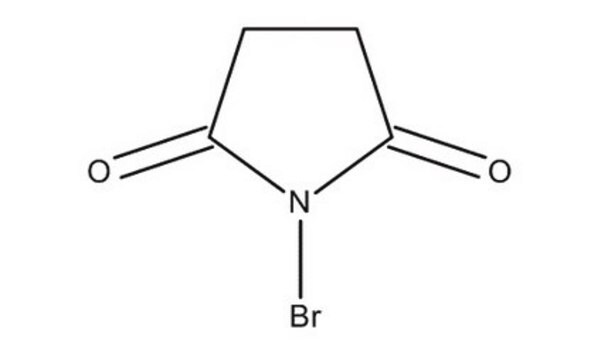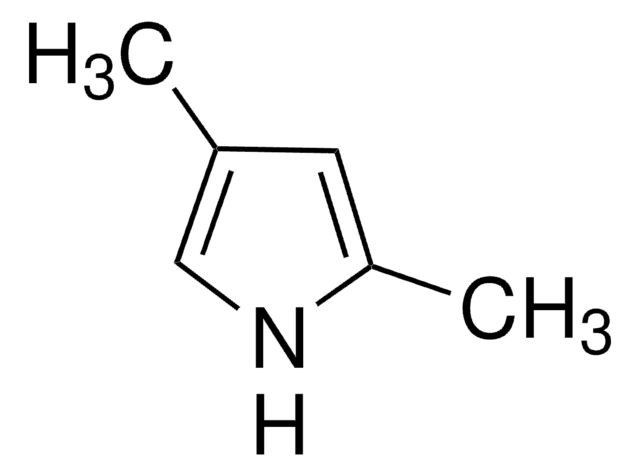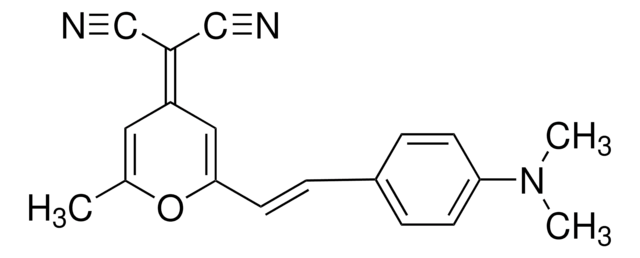746169
Difluoro(4-(1,1-dimethylethyl)-2-{1-[4-(1,1-dimethylethyl)-3,5-dimethyl-2H-pyrrol-2-ylidene-N]ethyl}-3,5-dimethyl-1H-pyrrol-2-ylidene-N]ethyl}-3,5-dimethyl-1H-pyrrolato-N)boron
98% (HPLC)
Sinonimo/i:
Boron,[4-(1,1-dimethylethyl)-2-[1-[4-(1,1-dimethylethyl)-3,5-dimethyl-2H-pyrrol-2-ylidene]ethyl]-3,5-dimethyl-1H-pyrrolato-N1,N2]difluoro-, PM 570, PM 596, PM 597, Pyrromethene 570, Pyrromethene 596, Pyrromethene 597
About This Item
Prodotti consigliati
Livello qualitativo
Saggio
98% (HPLC)
Forma fisica
powder
Punto di fusione
256-261 °C
λmax
526 nm in dichloromethane
Stringa SMILE
CC(C1=C(C)C(C(C)(C)C)=C(C)N1B(F)2F)=C3[N]2=C(C)C(C(C)(C)C)=C3C
InChI
1S/C22H33BF2N2/c1-12-17(21(6,7)8)15(4)26-19(12)14(3)20-13(2)18(22(9,10)11)16(5)27(20)23(26,24)25/h1-11H3
SEHGNHOGQDPQRC-UHFFFAOYSA-N
Categorie correlate
Descrizione generale
Applicazioni
Also used for solid-state dye laser devices and organic solar cells.
Codice della classe di stoccaggio
11 - Combustible Solids
Classe di pericolosità dell'acqua (WGK)
WGK 3
Punto d’infiammabilità (°F)
Not applicable
Punto d’infiammabilità (°C)
Not applicable
Scegli una delle versioni più recenti:
Certificati d'analisi (COA)
Non trovi la versione di tuo interesse?
Se hai bisogno di una versione specifica, puoi cercare il certificato tramite il numero di lotto.
Possiedi già questo prodotto?
I documenti relativi ai prodotti acquistati recentemente sono disponibili nell’Archivio dei documenti.
I clienti hanno visto anche
Il team dei nostri ricercatori vanta grande esperienza in tutte le aree della ricerca quali Life Science, scienza dei materiali, sintesi chimica, cromatografia, discipline analitiche, ecc..
Contatta l'Assistenza Tecnica.
![Difluoro{2-[1-(3,5-dimethyl-2H-pyrrol-2-ylidene-N)ethyl]-3,5-dimethyl-1H-pyrrolato-N}boron 99% (HPLC)](/deepweb/assets/sigmaaldrich/product/structures/196/394/4c2c0eae-f749-44bf-a37b-84bf0226092e/640/4c2c0eae-f749-44bf-a37b-84bf0226092e.png)
![Difluoro{2-[(3,5-dimethyl-2H-pyrrol-2-ylidene-N)methyl]-3,5-dimethyl-1H-pyrrolato-N}boron 99% (HPLC)](/deepweb/assets/sigmaaldrich/product/structures/518/861/c19c64be-654e-472e-a069-30ffccb1a8cd/640/c19c64be-654e-472e-a069-30ffccb1a8cd.png)







